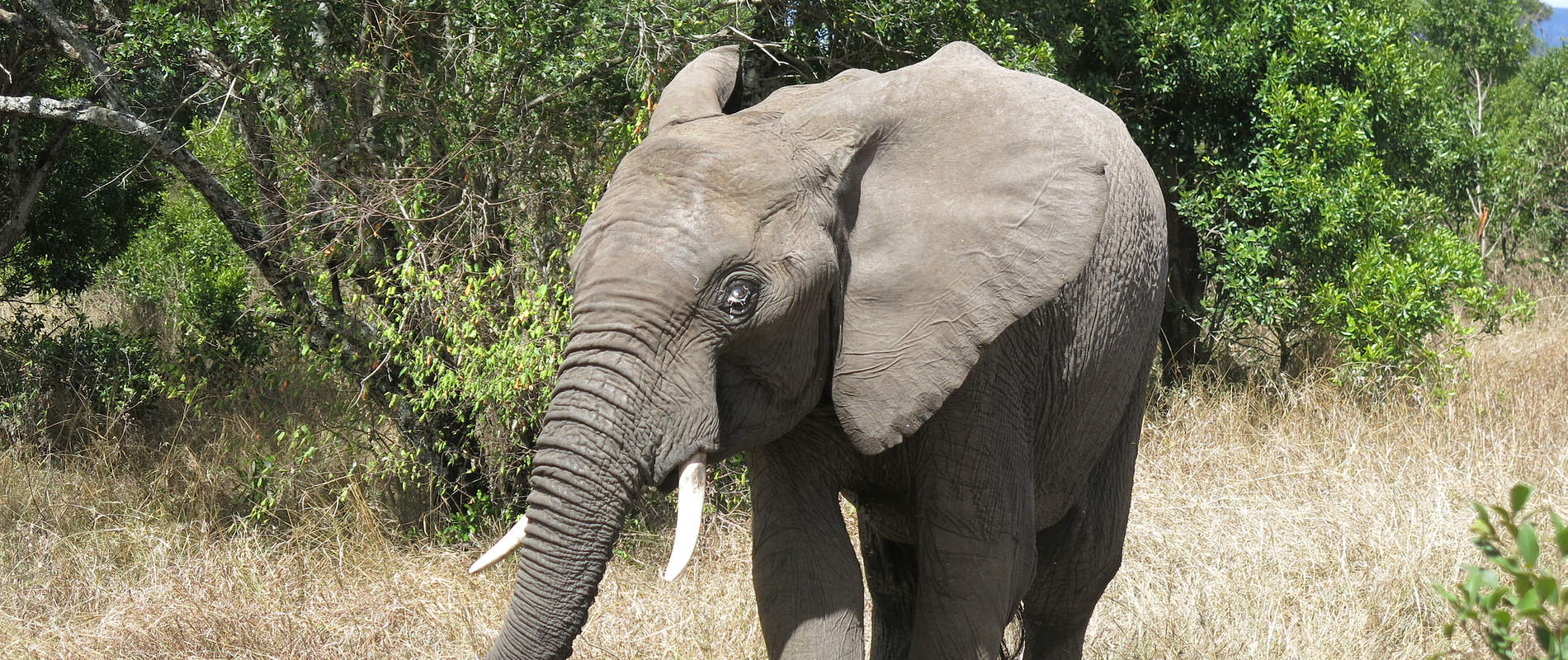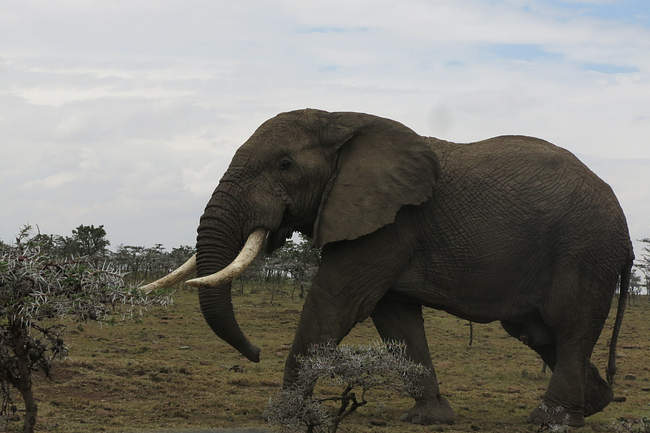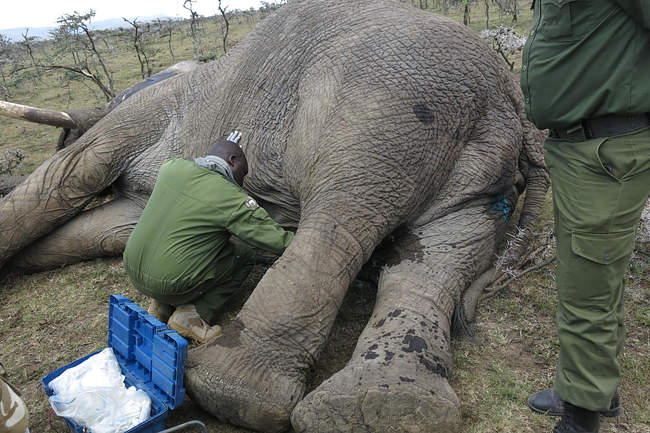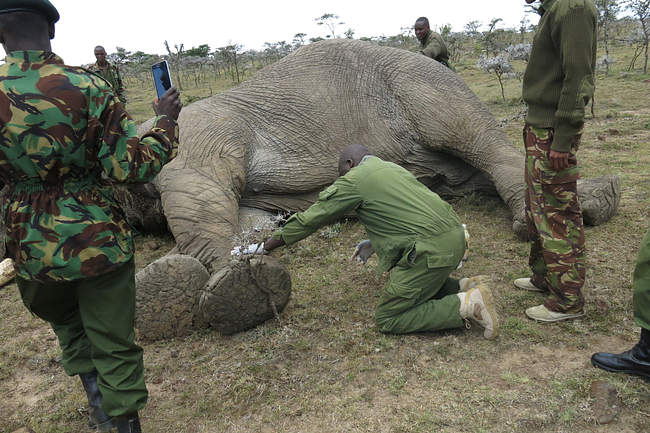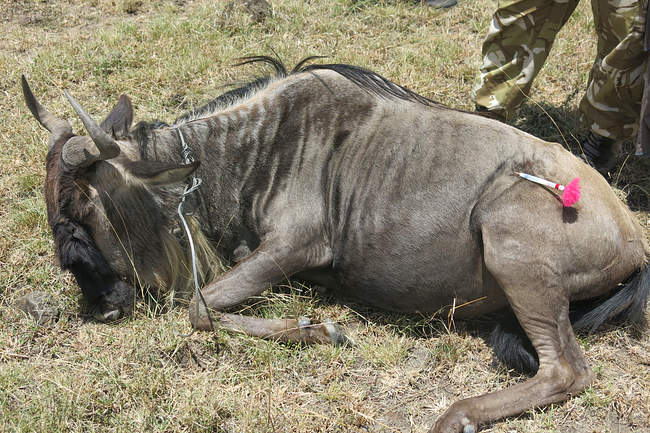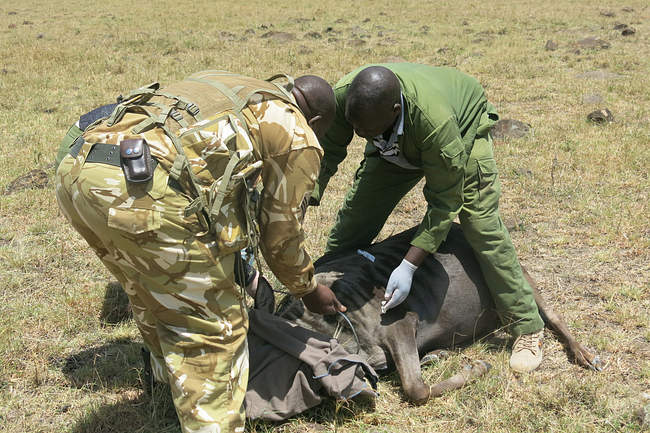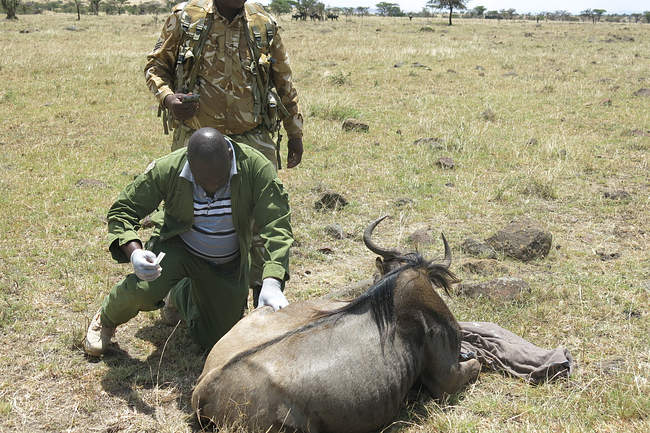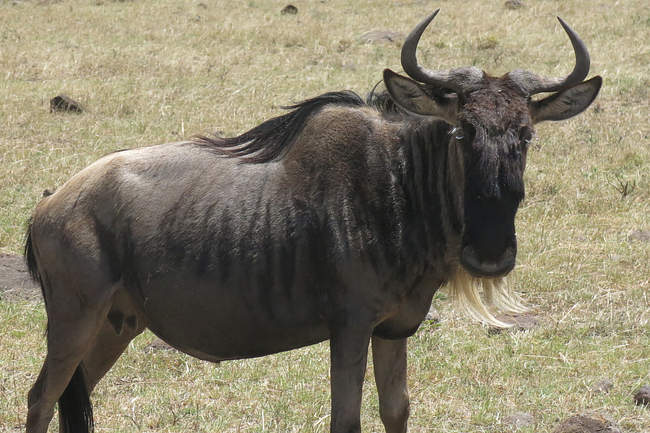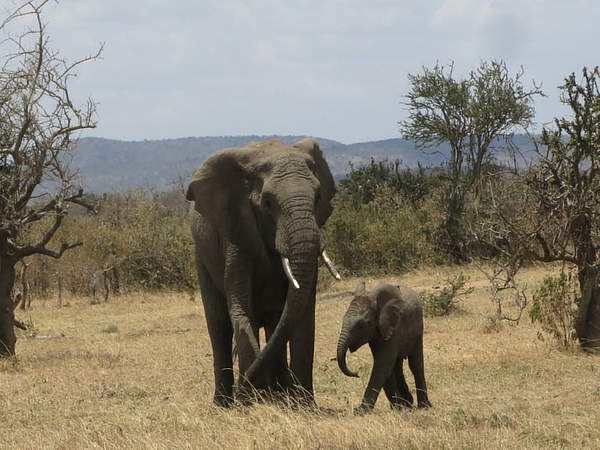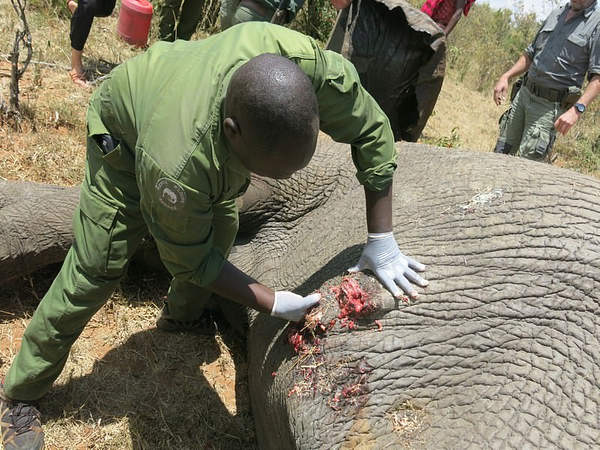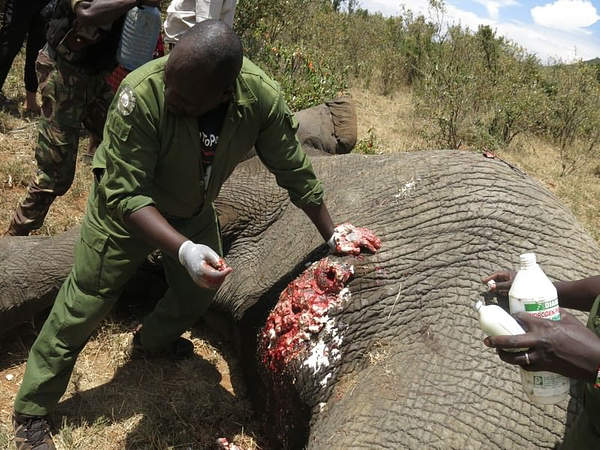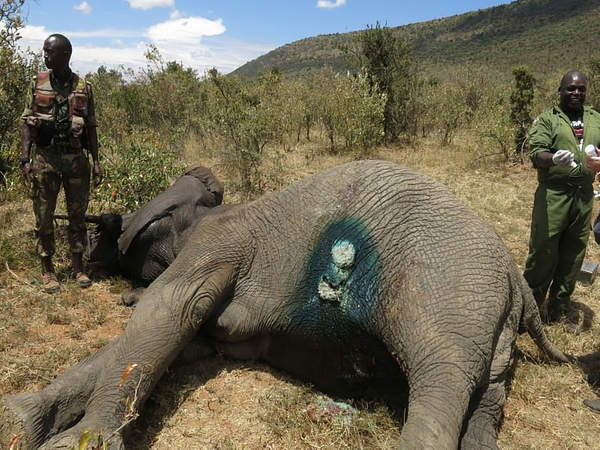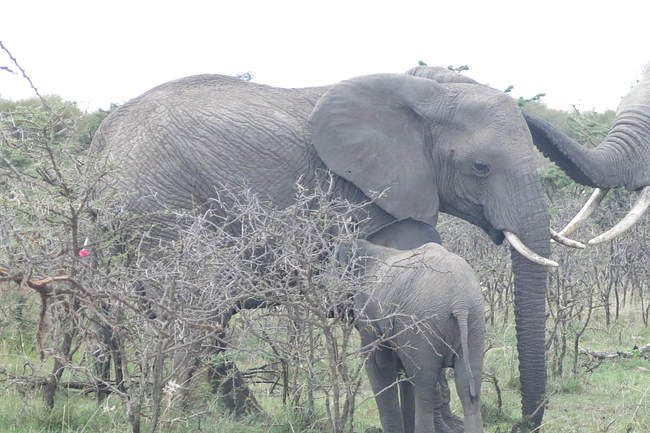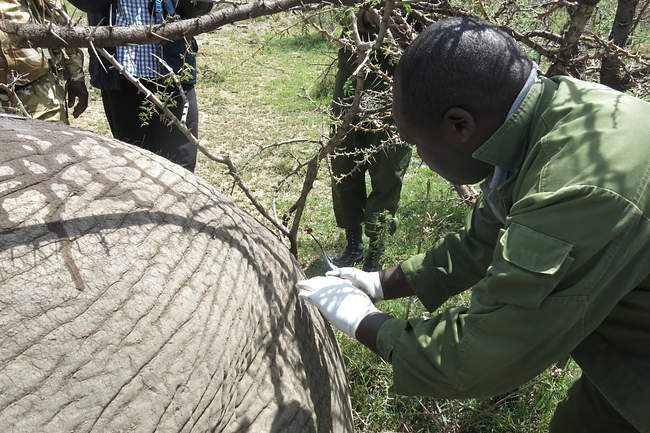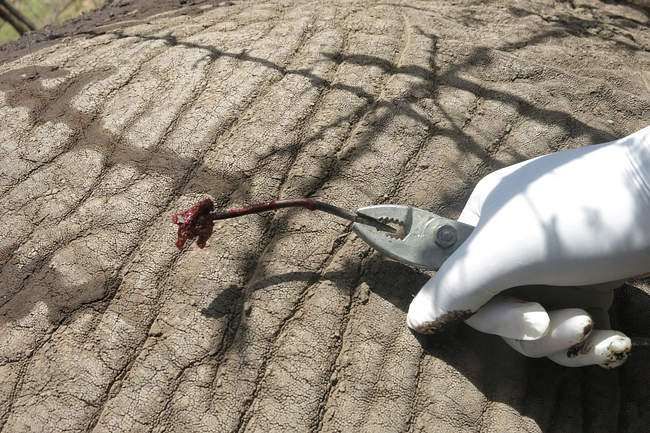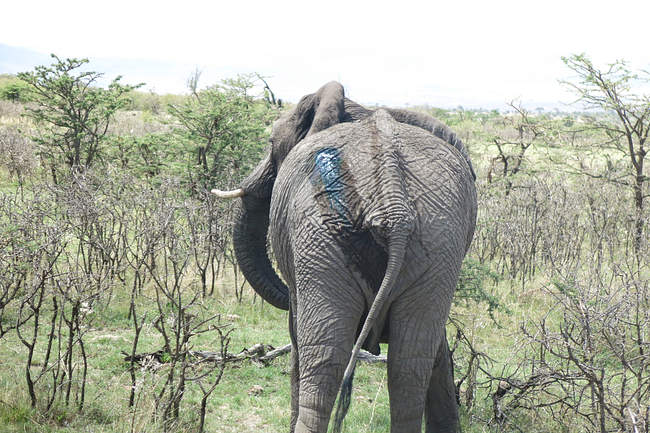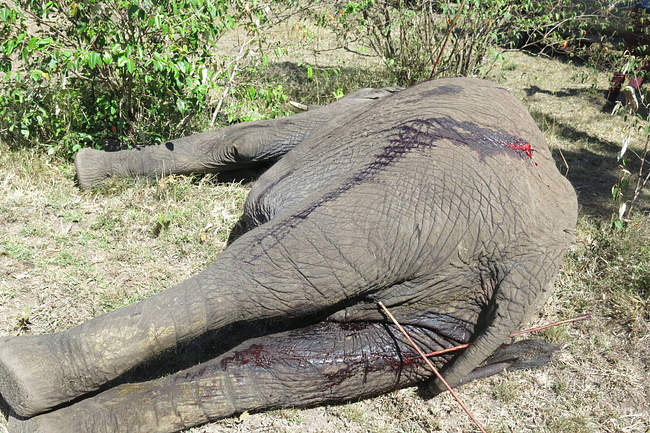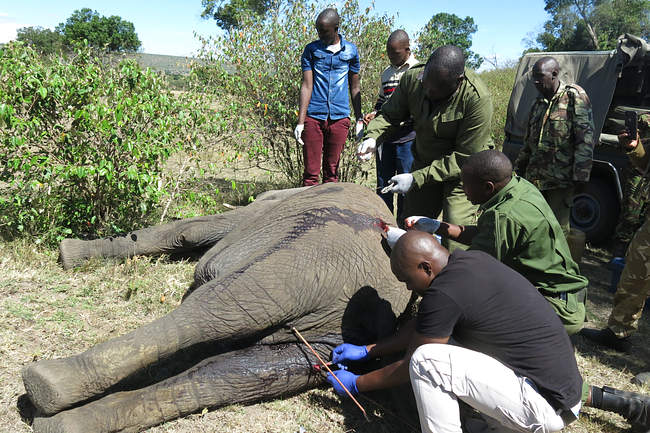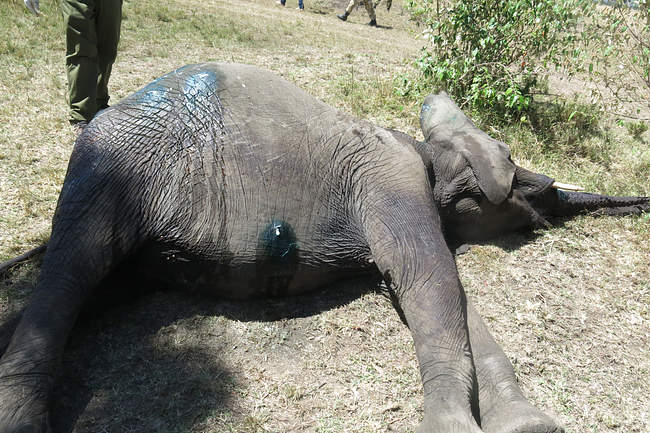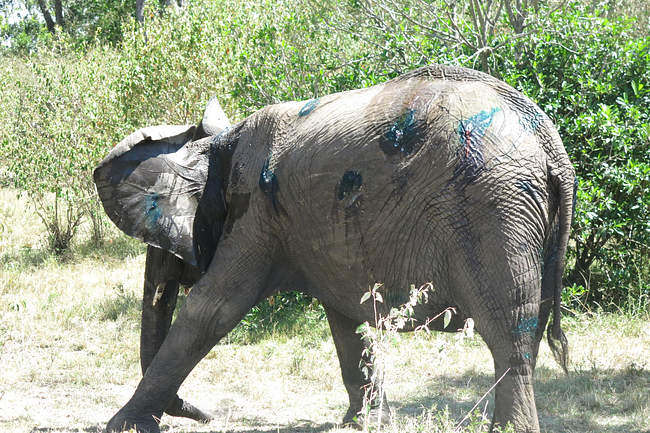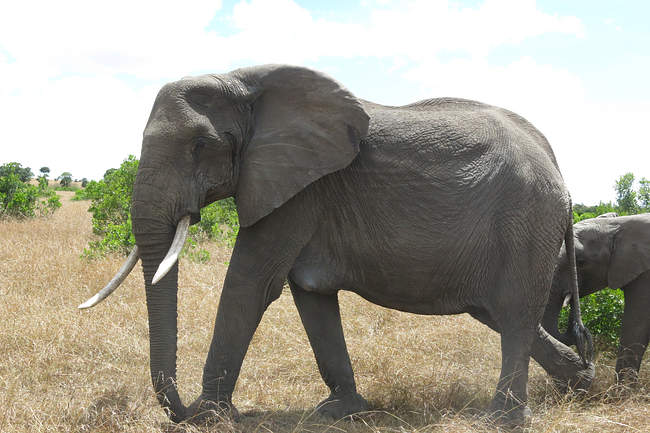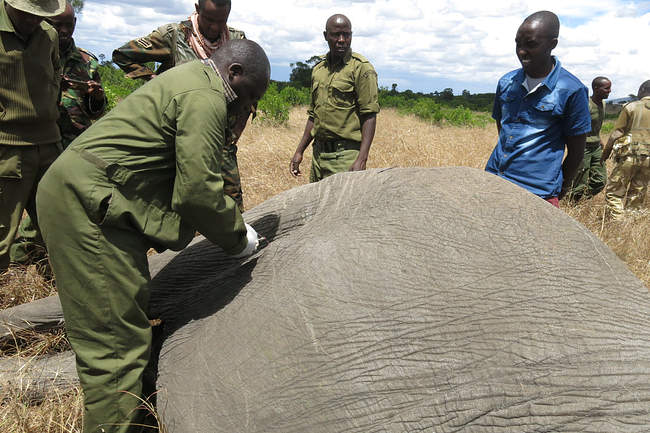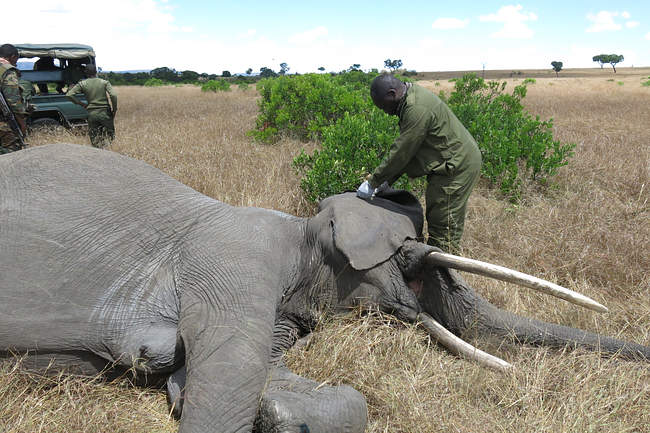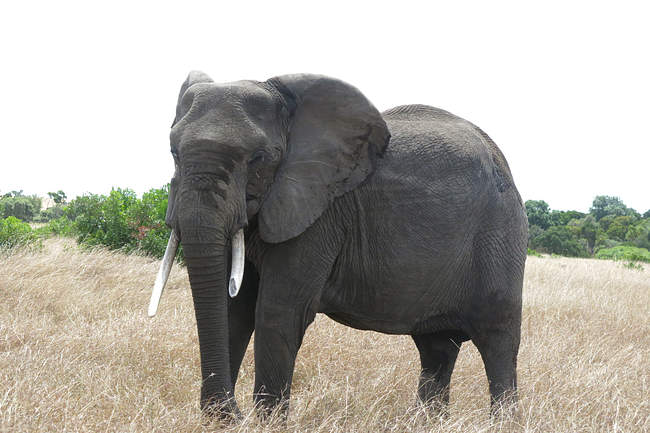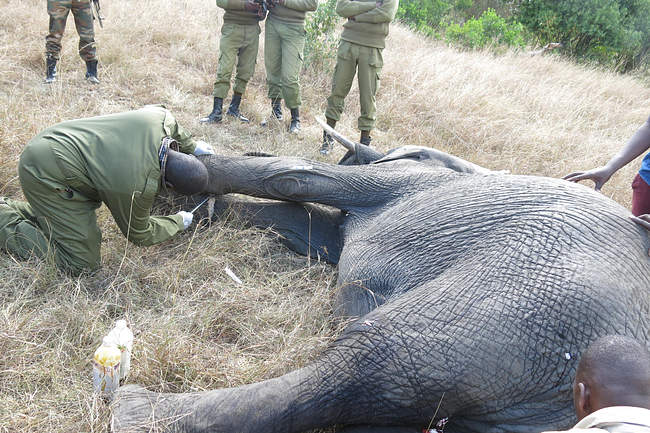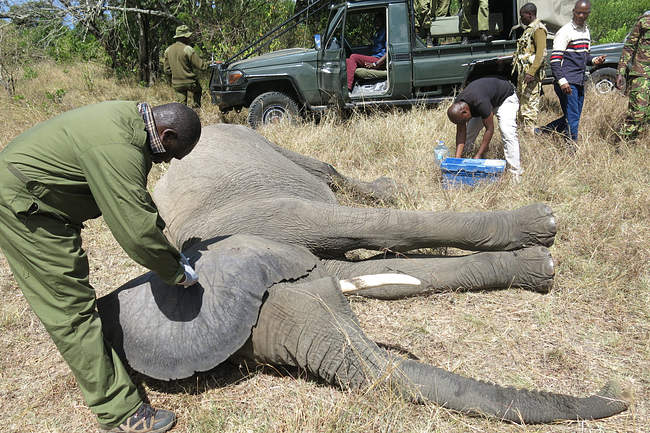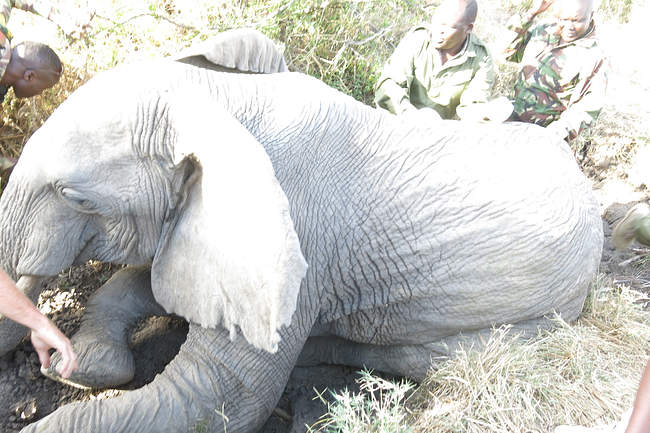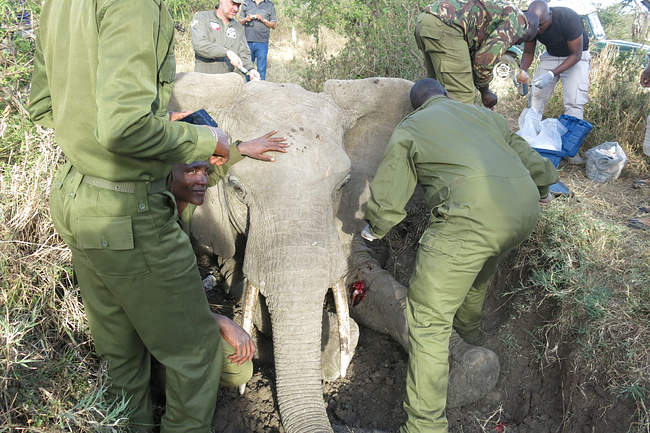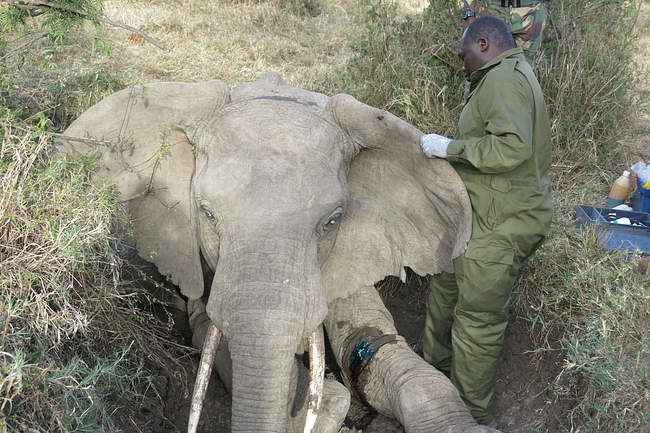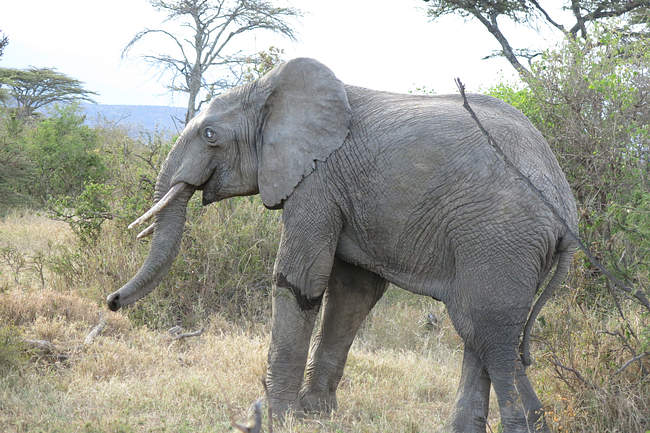The month under review was characterised by long dry spells, with little to no rainfall. The team dealt with ten cases this month, majority of which involving the treatment of injured elephants.
Due to previous rains, there is plenty of water for the animals, and adequate forage for the herbivores to eat. Among the cases handled during the month were three elephants treated for arrow wounds having crossed over to community areas with one harbouring twenty arrows which were all removed. Luckily none of the arrows were poisoned.
CASE#1 INJURED ELEPHANT BULL
Date: 9th October 2018
Species: African elephant
Sex: Male
Age: Adult
Location: Naboisho Conservancy
History
This big bull was seen limping by Naboisho Conservancy rangers who requested intervention by the Mobile Veterinary Unit through their management. This big bull was spotted alone in a relatively open area with a limping gait on motion. He appeared to favour his left forelimb. He remained calm on approach.
Immobilization, examination and treatment
Restraint was achieved by use of 16mgs Etorphine Hydrochloride delivered through a 3ml daninject dart.Darting was done from a vehicle with this bull moving for a small distance before becoming fully anesthetized. After ensuring he was stable, examination was conducted revealing a small wound just above his left sole. This posteriorly located wound appeared to be caused by a spear. Further examination revealed an old arrow wound on his left inguinal area. All the wounds were slightly septic. They were debrided with the help of Hydrogen Peroxide and rinsed with clean water before being disinfected with Tincture of Iodine. Additionally green clay was packed into the wound to prevent sepsis. He was also given 30000mgs Amoxicillin antibiotic and 5000mgs Flunixin anti-inflammatories all parenterally.
Reversal and prognosis
Reversal was done by administration of 42mgs Diprenorphine Hydrochloride through a prominent ear vein. He woke up within three minutes of reversal and walked away. Prognosis for full recovery is good.

CASE#2 SNARED WILDEBEEST
Date: 12th October 2018
Species: Wildebeest
Sex: Female
Age: Adult
Location: Olare Motorogi Conservancy
History
This adult female was part of a big migratory herd currently located in various parts of Masai Mara. It is common to spot a number with snares as they get trapped by intentionally set snares as they move from Serengeti to Masai Mara. She was seen dragging a snare that was loosely attached to her neck by Olare Motorogi rangers who called the Mobile Veterinary Unit for intervention. She was found with other wildebeests grazing, with a calf about one and half years old.
Immobilization, examination and treatment
Restraint was achieved by use of a combination of 5mgs Etorphine Hydrochloride and 50mgs Azaperone Tartarate delivered through a 1.5ml daninject dart. Darting was done from a vehicle. It took four minutes for the drugs to take full effect. She assumed sternal recumbency and the loose cable wire snare was removed. No injuries had been caused by the snare and there was no necessity for any medication.
Reversal and prognosis
Reversal was achieved by administration of 18mgs Diprenorphine intravenously through the jugular vein. She was up in two minutes to join her waiting calf. Given that there were no injuries from the snare, this wildebeest will continue to live normally.
CASE#3 INJURED ELEPHANT IN OLARRO
Date: 14th October 2018
Species: African elephant
Sex: Female
Age: Adult
Location: Olarro conservancy
History
This elephant cow was seen by Olarro Conservancy management with a septic wound on her lower left abdomen. They requested the services of the Mobile Veterinary Unit for intervention. She was seen in the company of her two calves, one approximately 6 month old and the other one about five years old. They were up a bushy hill inaccessible by vehicle and a helicopter was called in to assist.
Immobilization, examination and treatment
Immobilization was achieved by use of 15mgs Etorphine Hydrochloride delivered remotely through a 1.5ml daninject dart from a helicopter. This was done after the mother and the calves were gently driven down the hill into a relatively open ground. The drugs took full effect after nine minutes and the bigger of the calves took care of the younger calf as they retreated away from the narcotised mother as she went recumbent. Both were being closely monitored by rangers as they stopped, calmed and waited a short distance from their mother under treatment. After re -positioning in order to access the injury, examination revealed a septic wound on her left abdomen caused by a spear. Probing yielded no foreign body. This was about a one week old wound. The spear did not access the peritoneal cavity and damages were confined to the abdominal muscles. The wound was debrided with the help of Hydrogen Peroxide and gauze swab, with all necrotic tissues and pus being cleared. A large amount of water was used to rinse the wound before Tincture of Iodine was applied to disinfect the wound. Finally green clay was packed to absorb toxins, prevent sepsis and hasten healing. Other treatments include parenteral administration of Amoxicillin antibiotics and Flunixin Meglumine anti-inflammatories.
Reversal and prognosis
Reversal was achieved by administration of 42mgs Diprenorphine Hydrochloride through a prominent ear vein. She woke up in three minutes surveyed the area before moving to join her calves. Prognosis for full recovery is good.
CASE#4 INJURED ELEPHANT AT NABOISHO
Date: 21st October 2018
Species: African elephant
Sex: Female
Age: Adult
Location: Naboisho conservancy
History
This elephant with an arrowhead sticking from her left rump was seen and reported to the veterinary unit by the Conservancy management. This young adult was seen with other members of her herd browsing. She appeared restless and kept on twitching her tail in an attempt to remove the arrow.
Immobilization, examination and treatment
Immobilization was achieved by use of 15mgs Etorphine Hydrochloride delivered through a 1.5ml daninject dart from a vehicle. It took eight minutes for the drugs to take full effect. After placing her in a more comfortable posture, examination was conducted which revealed an arrowhead lodged on her left rump which could have been lodged there for about a day. The barbed arrowhead was gently worked out with the resultant wound being debrided with the help of Hydrogen Peroxide and gauze swab. Clean water was used to rinse the wound while Tincture of Iodine was applied for disinfection. She was also administered Amoxicillin antibiotics and Flunixin Meglumine anti-inflammatories parenterally.
Reversal and prognosis
Achieved by administration of 42mgs Diprenorphine Hydrochloride intravenously through a prominent ear vein. She woke up in three minutes to join the other family members. Prognosis for full recovery is good. Given this was a non poisoned arrow, no complications are expected.
CASE#5 POST MORTEM OF A YOUNG ELEPHANT COW
Date: 21st October 2018
Species: African elephant
Age: Approximately 13 years
Sex: Female
Location: Oloosokon
History
This young elephant cow was found dead on the morning of the 21st of October 2018, by KWS patrol rangers together with Mara Elephant Project and Mara North Conservancy rangers. They requested the Mobile Veterinary Unit services to establish the cause of her death.
General observation of the carcass
· This was a relatively fresh carcass estimated to be less than 24 hours old.
· She was found on right lateral recumbency. No external injuries were seen even after turning the carcass over.
· She appeared to have been in good body condition before death with a scale of 4.5 out of 5 where 1 is poor and 5 perfect.
· There was no evidence of a struggle before death at the scene.
· Both tusks were intact.

On opening the carcass, the following findings were noted
i. The gastro- intestinal tract appeared normal with ingesta traced in the entire tract, observed to be normal in consistency and quantity.
ii. There were petechial haemorrhages in most parts of her sub cutis.
iii. There was gravity dependent congestion on the right lateral side of her body, this being the position she remained in after death.
iv. The lungs appeared congested and haemorrhagic.
v. Liver and kidneys appeared congested.
vi. Of significance was the finding in the heart where a massive floating thrombus was found on the right heart extending from the right atrium into the right ventricles. This could have emanated from the lungs as a dissemination of pulmonary thrombi.
Conclusion
This elephant could have died from complications of the thrombi within her heart which effectively caused deficiency in cardiac functions hence sudden death. Both tusks were retrieved and taken to custody by KWS security team.
Our Mobile Vet Units are in the field every day saving wild lives
CASE#6 INJURED LION
Date: 21st October 2018
Species: African lion
Sex: Male
Age: Adult (Approximately 8 years)
Location: Mara North Conservancy
History
This adult male was seen on the morning of the 21st of October near an airstrip by Mara North Conservancy rangers. He was said to be writhing in pain with suspected fracture of one of his hind legs. He was unable to move and they requested the services of the Mobile Veterinary Unit for assessment and way forward. He was found lying under a shade in pain and unable to move. Right hind leg appeared injured and swinging. He had bite wounds on his face likely caused by other lions in competition for territories.
Immobilization, examination and treatment
This big male was chemically restrained with a combination of 250mgs Ketamine Hydrochloride and 6mgs Medetomidine Hydrochloride delivered through a 3ml dan-inject dart. Darting was done from a vehicle. He did not make any moves upon darting but rolled over obviously in pain. He was completely anaesthetized after ten minutes with examination revealing a nasty injury on his right hind leg which involved a compound fracture of his tibia fibula bone. There were also bite wounds around the fracture area and on his face. After thorough examination and assessment and exploring all options, this lion appeared to be in great pain with grave prognosis. It was decided that his further suffering be halted by humanely putting him down. This was effectively done by intravenous administration of 20% Pentobarbitone Sodium. The carcass was then disposed of properly.

CASE#7 DYSTOCIA IN A GIRAFFE
Date: 23rd October 2018
Species: Masai giraffe
Sex: Female
Age: Adult
Location: Masai Mara National Reserve
History
This giraffe with partly ex-pulsed foetus was seen by a tour guide who simultaneously informed the Mobile Veterinary Unit and Mara Reserve Management. She was found with a small herd of giraffes with foetal legs hanging from the vulva. She appeared weak with a foul smell emanating from the already dead foetus. The giraffe appeared severely bloated.

Immobilization and treatment
A lower dose of 8mgs Etorphine Hydrochloride and 30mgs Azaperone was prepared and delivered through a 1.5ml daninject dart. Darting was done from a vehicle with this giraffe moving briefly before succumbing to the anaesthetics. She was reversed immediately and restrained physically while examination was being conducted. This was a severely emphysematous foetus which could have been partially hanging out for the last 5 days. The female foetus had presented anteriorly with left lateral neck flexion. Putrefaction of the foetus was beginning to occur. There were signs of severe sepsis to the mother from uterine infection following the death of the foetus and setting in of gas forming bacteria. This giraffe died while being examined and post mortem conducted revealed a severely emphysematous foetus occupying the entire uterus which had already been perforated. This giraffe died of severe septic shock aggravated by capture.
CASE#8 POST MORTEM OF AN ELEPHANT BULL
Date: 27th October 2018
Species: African elephant
Sex: Male
Age: Adult
Location: Kishermuruak
History
The carcass of this elephant was spotted in the morning by Olarro Conservancy managers together with their rangers on patrol. They called the Mobile Veterinary Unit to establish the bull’s cause of death. It was further reported that a group of elephants in his herd had moved into a nearby tomato farm a few days prior to his death.
General observation
· This young bull was found lying on his right lateral side with clotted blood at the tip of his
nostrils.
· Both tusks were intact.
· No injuries were seen externally, even with turning the carcass over.
· First stage maggots were beginning to infest. Age of the carcass suspected to be 48 hours.
· There was no evidence of struggle at the scene before death.
· He appeared to have been in good body condition before death. A scale of 4 out of 5 where 5 is perfect and 1 poor.
· There was severe cyanosis of the oral mucosa and tongue.
· The carcass appeared bloated with subcutaneous emphysema.

On opening the carcass, the following findings were noted
i. The gastrointestinal tract was full with evidence of recent feeding.
ii. The liver appeared congested with some zones showing cooked appearance.
iii. There was generalised petechia of sub cutis.
iv. The spleen appeared slightly enlarged otherwise normal in consistency.
v. The right kidney was normal in texture, size and colour.
vi. The left kidney had small purulent stuff emanating just beneath the cortex.
vii. Both lungs were severely congested.
viii. The heart appeared normal in size and architecture.
ix. A benign fatty mass was found firm within the abdomen considered to be a lipoma.
x. All other organs appeared normal.
xi. Liver, kidney and stomach content samples were collected for toxicological analysis.
Conclusion
Significant post-mortem findings which include presence of suspected lipoma, and pus from left kidney were noted but was felt could not have led to his sudden death. Results from samples taken are meanwhile awaited to shed light on the cause of his death.
CASE#9 INJURED ELEPHANTS
Date: 28th October 2018
Species: African elephants
Sex: 2 females and 1 male
Age: 1 adult female, 1 sub adult male and 1 young female.
Location: Mara North Conservancy.
History
Mara Elephant Project, Mara North Conservancy and KWS security teams on joint patrols reported an incident of attack on a group of elephants by some community members. Several elephants were injured with a number of them escaping with lodged arrows. Services of the Mobile Veterinary Unit were sought to help treat these injured elephants. Three of them had arrows lodged and deserved intervention while the rest appeared out of danger.
Elephant 1:
This young female about 8 years old was located in a thicket with several arrows hanging from almost every part of her body. She was in great pain and bleeding from the injuries. She was reluctant to come out from the bush and very elusive
Immobilization, examination and treatment
Restraint was achieved by use of 8mgs Etorphine Hydrochloride delivered remotely through a 1.5ml dan-inject dart. Due to the terrain, darting was done on foot. The drugs took full effect after seven minutes with this young elephant assuming left lateral recumbency. Several arrows were lodged in her body others still harbouring shafts. All of them were barbed and were carefully dissected out. Almost every part of her body including the head and trunk had arrows lodged. She was turned over and more arrows were retrieved from the other side of the body. Additional injuries from fallen arrowheads were also treated. In total twenty arrows were removed and this young elephant had been in great pain. All the resultant wounds were debrided with Hydrogen Peroxide, rinsed with clean water, disinfected with Tincture of Iodine and infused with Cloxacillin wound ointment. Additionally she received Amoxicillin antibiotics and Flunixin Meglumine anti-inflammatories parenterally.
Reversal and prognosis
Reversal was achieved by intravenous administration of 24mgs Diprenorphine Hydrochloride through a prominent ear vein. She woke up after three minutes and retreated deeper into the thicket. Given that none of the arrows appeared poisoned, this elephant has a good chance of full recovery.
Elephant 2:
This old female about 50 years old appeared to be the matriarch of the family. She had a 4 year old calf and in company of the rest of the family members and the bigger herd. She was located at a nearby thicket having moved some distance from the injured young female. She had two arrowheads, one lodged on her right flank slightly off the spine and another one on her right midbelly.
Immobilization, examination and treatment
She was restrained chemically by use of 15mgs Etorphine Hydrochloride delivered through a 1.5ml dan-inject dart. Darting was done from a vehicle with the drugs taking full effect after eight minutes. She assumed right lateral recumbency. Examination revealed there were no extra injuries apart from the two lodged arrowheads which were gently removed and resultant wounds managed like the earlier case. None of the arrowheads were poisoned.
Reversal and prognosis
Reversal was achieved by administration of 42mgs Diprenorphine Hydrochloride intravenously through a prominent ear vein. She rose up in two minutes to join her patiently waiting family members. Prognosis for full recovery is good.
Elephant 3:
This young bull about ten years old was traced and located in the same herd with the injured matriarch. He had an arrowhead lodged on the posterior side of his left thigh. He was also limping with an injury on his front left leg.
Immobilization, examination and treatment
Immobilization was achieved by use of 10mgs Etorphine Hydrochloride delivered through a 1.5ml dan-inject dart. Darting was done from a vehicle with this bull assuming right lateral recumbency upon full narcotization after eight minutes. Examination revealed an arrowhead lodged on his left thigh which was gently removed. This was a non poisoned arrow. Further examination revealed a deep spear wound on the inner side, mid on his left front leg. All the wounds were managed the same way as the first two cases and received similar treatments.
Reversal and prognosis
Reversal was achieved by administration of 30mgs Diprenorphine intravenously through a prominent ear vein. He rose up in three minutes to join a nearby herd of elephants. Prognosis for full recovery is good. The arrowhead appeared free of poison.
CASE#10 INJURED ELEPHANT BULL
Date: 28th October 2018
Species: African elephant
Age: Approximately 15 years old
Sex: Male
Location: Olarro conservancy
History
This young bull, in the company of seven other big bulls, was seen by Olarro rangers with an arrow sticking out of the right side of his flank. He also had an injury on the medial side of his left shoulder. They requested the services of the Mobile Veterinary Unit for intervention.
Immobilization, examination and treatment
He was chemically restrained with the use of 12mgs Etorphine Hydrochloride delivered remotely through a 1.5ml dan-inject dart. Darting was done from a vehicle. It took seven minutes for the drugs to take full effect with this bull assuming sternal recumbency in a small lugga. The team decided to work on this elephant with this posture but quickly with close monitoring given that there was no adequate space to push him over to lie on one side. Examination revealed a recently lodged arrowhead on his right flank which was gently worked out. The wound on the left front leg was septic but without any foreign body and thought to be caused by a spear. All the wounds were debrided with Hydrogen Peroxide and gauze swab. Clean water was used for rinsing before the wounds were disinfected with Tincture of Iodine. Cloxacillin antibiotic ointment was then infused. Other treatments given include parenteral administration of Amoxicillin antibiotics and Flunixin Meglumine anti-inflammatory.
Reversal and prognosis
Reversal was achieved by intravenous administration of 36mgs diprenorphine hydrochloride. He woke up three minutes after reversal to join the big bulls. Prognosis for full recovery is good.
Acknowledgements:
Report by Dr. Campaign Limo. Mara Mobile Veterinary Unit would like to thank all stakeholders for their role in reporting and locating various cases handled during the month. Thanks to the Minara foundation through The DSWT for their continued facilitation to the unit. Thanks too to KWS management for their support and technical advice to the unit.
